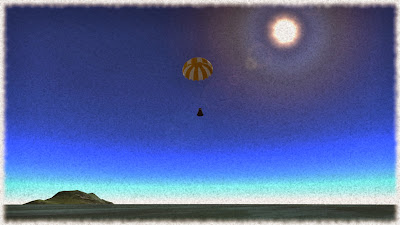For the first part of this this year, the staff at the Kerbal Space Center have been working through Phase-One of Project: Unity. This part of the Space Program will not only see the first Kerbals in space, but will also carry out some complex manned maneuvers that are necessary steps for sending Kerbals to the Mun.
'The first phase of Project Unity is safety,' said Gene Kerman, the Flight Director that has been in the public eye right from the beginning. 'Because there are some very different and complex elements to this project, it has been broken down into three phases. The first phase has tested out a 'Launch Escape System', which is vital equipment that will pull the pilots' capsule to safety if they should run into trouble. There are quite a few tests this kit needed to be put through to make space flight safer. And I'm pleased to say that we now have a working escape system.'
There were a total of six flights that put the Launch Escape System (LES) through various situations. These ranged from a static launch-pad firing right through to a full mid-flight abort. Unity I was perhaps the most simplest of tests and just proved that the system was able to carry the new Mk1 Command Pod off the ground.
Unity I sat at the launch pad ready to try out the new LES
Unity I at launch. The LES managed to pull the new Command Pod three-hundred meters into the air at an acceleration of 3g's
Unity I parachutes safely back to the ground
Fourteen days after the first test, the project continued with the launch of Unity II. This time, the Command Pod sat on top of a new launch vehicle named Sprite. This solid-fuel rocket booster was last seen during the R-Series vehicles three years ago. They have now made a return as a testing platform for these initial stages of the project.
Unity II sat on the launchpad ready for a static test atop the new Sprite booster to simulate a launchpad emergency
Unity II makes a successful separation and parachutes safely back to Kerbin
Unity III was when things started to get more interesting. This would see the project have it's first live launch and put both the Command Pod and the LES through their paces. Mounted on another Sprite launch-vehicle, Unity III took to the skies. Once the booster was out of fuel, the LES would then attempt to pull the Command Pod away from the rocket. At an altitude of nearly nineteen kilometers into the air, the LES was activated and achieved the goal successfully. The Command Pod also parachuted back to the ground, allowing scientists to recover the valuable data and prove that the capsule can survive a ground-landing from high altitude.
Launch of Unity III using the Sprite LV. The rocket went on a simple straight-up trajectory
Unity IV was much the same test as Unity III, except this time the launch was set to fly over the ocean. This test would ensure the LES could pull the capsule away at more horizontal attitude as well as test the capsules buoyancy in the water at splashdown. All elements of the test proved to be a success.
Unity IV ready for launch on it's horizontal abort test
An impressive shot of Unity IV at launch as it heads out to Booster Bay
The next test phase saw the Unity V capsule mounted on top of the awaited Falcon launch vehicle. This is a liquid-fulled booster and is a modified version of the Union first-stage. This rocket variant will be the model that will send the first Kerbals into space. Even though the LES had proved itself successful, it still had to be tried on the much more powerful Falcon rocket. The main difference is the abort would take place mid burn. A system would trigger the engine to shut down at the moment the LES is operated to pull the capsule away. Although this was successful, the shape of the capsule made it tumble violently over during the abort sequence. Even though this proved the aerodynamics of the capsule were working, medical staff had concerns over the speed at which this occurred. The Pod, however, was successfully recovered from the sea.
Unity V launches on top of the new Falcon launch vehicle
The final test in the first phase of Project: Unity saw a repeat of Unity V. However, the RCS system on board of the Command Pod was activated before the abort to see if it would reduced the effects of the capsule-tumble during the abort operation. There was not much difference, but the medical teams were content that a dizzy head was better than a fatal crash.
Unity VI closes out the first phase with a successful splashdown in Booster Bay
Phase-One of Project: Unity is now complete. Future Kerbal astronauts can sleep safe knowing that there is a successful launch system that will pull them to safety during launch should trouble arise. Phase-Two will start soon and will be the unmanned sub-orbital launch tests to ensure the Command Pod functions as it should when in the vacuum of space.











No comments:
Post a Comment